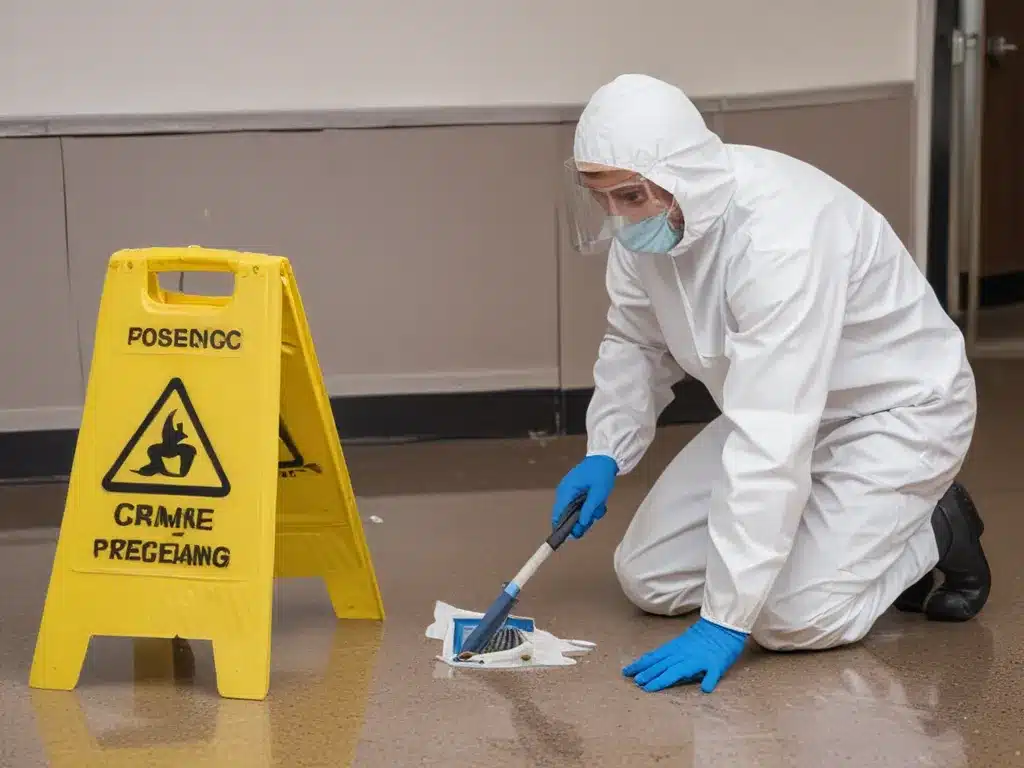Crime scenes present unique hazards and contamination risks. As a crime scene cleaner, I follow strict protocols to protect evidence and safely sanitize affected areas. Proper protocols preserve forensic evidence, ensure my safety, and prevent further trauma to victims’ families.
Documenting the Scene
Before cleaning a crime scene, I thoroughly document conditions. Photographing blood patterns, bullet trajectories, and body fluid stains provides crucial forensic evidence. I sketch the layout, measure key dimensions like blood spatter size and distance, and log environmental details. My field notes supplement photographic documentation, creating a permanent record for investigators.
Thorough documentation preserves critical trace evidence that could otherwise be lost during cleaning. For example, wiping up blood destroys DNA and fingerprint evidence. My documentation lets investigators reconstruct the scene virtually after cleaning.
Protecting Evidence
Preserving evidence is my top priority. I avoid disturbing or destroying potential clues. For example, I don’t wash bedding or clothing items, as they may contain trace evidence like hairs or fibers. When moving furniture or objects, I wear disposable gloves to prevent contamination.
I cordon off areas containing key evidence like blood splatters. Investigators can then analyze patterns before I clean. For bullet holes, I avoid drilling out projectiles or wiping surrounding surfaces. I may cover openings to prevent cross-contamination.
My cleaning techniques are designed to preserve evidence. I use low-pressure rinsing instead of heavy scrubbing that could wash away blood splatter or DNA traces. Gentle misting preserves evidence while effectively sanitizing.
Personal Protective Equipment
Crime scenes contain biohazards like bodily fluids, bacteria, viruses, and dangerous chemicals. I wear extensive personal protective equipment (PPE) to guard against exposure.
At minimum, I don PPE including:
- Nitrile gloves – protect against bloodborne pathogens and chemicals
- Goggles – prevent fluid splashes into eyes
- Face shield – provides full face protection
- Coveralls – prevent skin exposure
- Rubber boots – prevent blood absorption into shoes
For highly hazardous scenes involving decomposition, asbestos, or chemical spills, I add:
- P100 respirators – filter airborne particulate matter
- Chemical-proof bodysuits – prevent caustic chemical exposure
Proper PPE is essential for safe crime scene cleaning. I avoid skin contact and inhalation of biohazardous substances. My equipment gets thoroughly disinfected or discarded after each scene.
Disinfection Procedures
My cleaning process focuses on neutralizing biohazards and removing potentially infectious materials. I follow medical-grade decontamination procedures according to OSHA and EPA standards.
For blood, I apply an oxidizing disinfectant containing chlorine to chemically neutralize potential pathogens. Bloodstains get misted with disinfectant, allowed to soak, then rinsed away.
For surfaces lacking visible blood, I sanitize using a quaternary ammonium detergent solution. This kills bacteria, viruses, and fungi. I also use antimicrobial fogging machines to disinfect entire rooms rapidly.
Disposal protocols are important too. I double-bag biohazardous waste in red bags for identification. A licensed medical waste company transports and incinerates contaminated materials. Proper disposal prevents further spread of infectious agents.
Restoration Techniques
After decontaminating a crime scene, I work to restore affected areas for survivors’ safety and peace of mind.
For hard surfaces, I use a HEPA vacuum and steam cleaner to remove any lingering odors, stains, or forensic chemicals. Steam helps deodorize while sanitizing porous materials.
For fabrics, carpets, and upholstery, I employ enzyme cleaners specially designed to digest organic matter like blood and bodily fluids. This removes odors and stains while neutralizing biohazards. Heavily soiled items may need replacement.
For structural materials like flooring and drywall, I repair and resurface damaged areas. This removes distressing visual reminders so families can reclaim their space. My restoration techniques erase traces of trauma after cleaning.
Psychological Considerations
Crime scenes affect survivors emotionally long after the physical cleaning is complete. I maintain sensitivity when interacting with grieving families on site. My protocols prioritize discretion and dignity for the deceased.
I avoid unnecessary disturbance of personal belongings and minimize intrusive foot traffic. My crew respects families’ space and privacy. We schedule work to accommodate burial services and gatherings.
Most importantly, I listen. This work brings overwhelming grief and trauma. Treating survivors with compassion is paramount. My highest duty is helping families heal.
By adhering to strict forensic protocols, I accomplish my dual objectives – preserving crucial evidence, and restoring order for devastated communities. With care and professionalism, I aim to provide some closure amidst tragedy.







